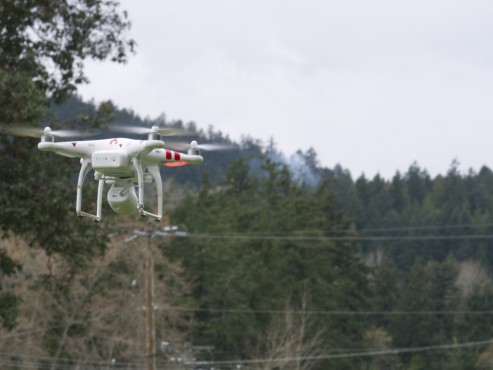Safety is the first priority at UAS 101, an Unmanned Aerial Systems flight school. The three-day course, run by David Carlos of Victoria Aerial Photos and Survey, is one of the few training opportunities in Western Canada for drone flight amidst the background of an emerging commercial industry.
During UAS 101, students learn the foundations of meteorology, air law, and flight theory on multi-rotor airframes, which culminates in a day of UAS flights.
Cheaper stabilization systems along with advances in digital video have led to a boom in consumer drones. “10 years ago, stability systems like this would cost thousands of dollars; now you can buy them in the store for 40 bucks,” said Carlos. The proliferation of UAS systems has led to both businesses and governments searching for ways to apply the technology.
Dave Lundy of the Central Saanich Fire Department participated in the course and sees lifesaving roles for UAS in fire suppression, hazardous materials, and search and rescue. A UAS equipped with a thermal camera could “look at roofs to see where the hotspots are,” said Lundy, locating “areas of a structure where the fire is most intense.” Carlos himself used his drone in the search for a missing hiker in East Sooke Park last year.
While the systems are capable of autonomous and stabilized flight, perhaps the most important lesson for students is that, despite technological advances, competent manual flying skills are critical if systems fail.
A quick YouTube search of “drone crashes” range from relatively harmless crashes where a pilot crashes into a parking lot wall, to potentially life threatening impacts into people, over busy streets, and even into historic buildings like Istanbul’s Blue Mosque.
“You should look at this as a flying Skilsaw,” said Carlos. “These aircraft can go rogue, [so] they need to be harnessed responsibly.”
“It’s a part of the emergency contingency plans and checklists that we teach and employ,” said Carlos. If an aircraft begins to act erratically there may be just seconds to stop a crash. “You have to be able to assume manual control of an aircraft at anytime. Reliance on auto-pilot can be a huge mistake.”
While agile and capable of high speeds, consumer drones still have their limitations.
According manufacturer specifications, the DJI Phantom 2 used on the course has 25 minutes of flight time and can carry a payload of 300 grams, or about a standard bag of chips. Larger models come with increased capacity, like DJI’s S1000 with a seven kilogram payload, but aircraft weighing more than two kilograms fall under tighter rules, requiring just the type of training offered in UAS 101.
Transport Canada regulations currently require pilots to apply for a Special Flight Operations Certificate (SFOC) to operate UAS systems greater than two kilograms, or any UAS within five nautical miles of a built-up area, effectively requiring an SFOC to fly anywhere within the Capital Regional District. Regulations restrict altitude to less than 90 metres and demand visual contact between pilot and drone. Carlos expects standards for UAS pilots to increase to a level similar to those of commercial manned aircraft, including health screening.
Despite the limitations, and without any established national players, upstarts like Victoria Aerial Photos and Survey are pioneering new applications in a potentially lucrative industry. A Business Insider Intelligence report forecasts commercial drone revenues in the billions over the next five years.
Entrepreneurs aren’t the only ones testing the waters in British Columbia. Frustrated by U.S. regulations, Amazon announced this week it has begun testing thirty-minute drone deliveries at a secret location in B.C.
Victoria Aerial Photos and Survey expects to run another flight school in May.
For more information, visit victoriaairphotos.com.
Clarification (4/09/2015): While the original article included the fact that a Special Flight Operations Certificate (SFOC) was required to fly drones heavier than two kilograms, it implied that a SFOC was not required to fly lighter drones in the CRD, when in fact a SFOC is required when flying drones of any weight class within five nautical miles of a built-up area, effectively requiring pilots to have a SFOC when operating a drone in the CRD. The article has been amended to reflect this.









